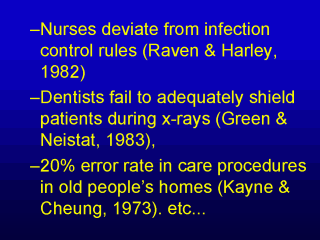| front |1 |2 |3 |4 |5 |6 |7 |8 |9 |10 |11 |12 |13 |14 |15 |16 |17 |18 |19 |20 |21 |22 |23 |24 |25 |26 |27 |28 |29 |review |
 |
Nurses, also, often deviate from
care practice guidelines, including rules for control of infection, often failing to wash
their hands between touching patients, or not administering analgesic medication as
required. These are a basic and simple practice, but work contingencies and a lack of
appreciation for the seriousness of their actions can drive the behaviour to the most
simple and least-effort route of care. Similarly, dentists unnecessarily expose patients to x-rays because they fail to correctly follow procedural guidelines closely enough. And so on. There are lots of different examples of this kind of problem. A further example is the high error rate in care procedures for older people in old people’s homes. You also cannot have failed to notice the recent spate of medical and nursing “errors” in Hong Kong’s hospitals, ranging from incorrect dialysis procedures through to medication errors. |